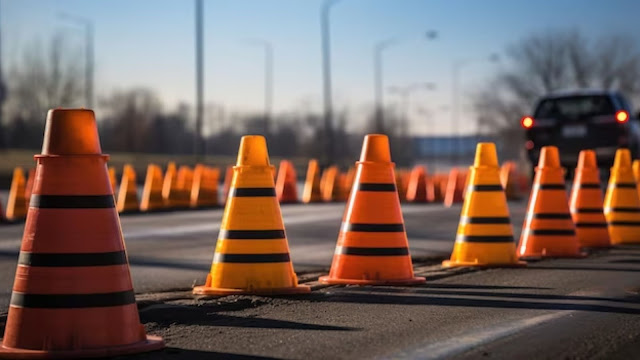Enhancing Safety: The Crucial Role of Traffic Cones in Construction Zones
Welcome, readers, to a discussion on a topic that is of utmost importance in the construction industry - safety. As we delve into the world of construction zones, it is crucial to emphasize the significance of maintaining a safe environment for both workers and the public. In this blog post, we will explore the pivotal role of traffic cones in ensuring safety within construction zones, shedding light on their indispensable function in mitigating potential hazards.
The responsibility of guaranteeing safety in construction zones extends beyond mere compliance with regulations; it encompasses the implementation of effective safety measures, one of which involves the strategic use of construction cone in Australia. These simple yet highly effective devices play a vital role in guiding traffic, marking hazards, and delineating work areas, thereby minimizing the risk of accidents and ensuring a secure environment for all involved.
Section 1: Understanding the Purpose of Traffic Cones
The primary purpose of traffic cones in construction zones is multi-faceted, encompassing various essential functions that contribute to overall safety. These bright orange beacons serve as visual cues, guiding both vehicular and pedestrian traffic around construction sites, redirecting flow, and ensuring that individuals stay clear of potential hazards. Moreover, they play a pivotal role in marking off specific areas, delineating boundaries, and alerting individuals to potential dangers, thus serving as a crucial line of defense against accidents.
The distinctive conical shape of these devices, coupled with their vibrant color, makes them easily noticeable, even from a distance. As a result, they effectively communicate warnings and directives to individuals navigating the construction zone, enhancing overall safety and minimizing the likelihood of mishaps.
Section 2: Compliance with Safety Regulations
In the realm of construction safety, adherence to regulatory standards is non-negotiable. The use of traffic cones in construction zones is not merely a matter of preference; it is a legal requirement aimed at safeguarding the well-being of workers and the public. These regulations, set forth by relevant authorities, mandate the use of traffic cones to demarcate work areas, mark hazards, and ensure a safe flow of traffic around construction sites.
By complying with these safety regulations, construction companies and contractors demonstrate their commitment to providing a secure working environment. Moreover, adherence to these standards significantly reduces the likelihood of accidents, protects against potential liability, and contributes to the overall professionalism and credibility of the construction operation.
Section 3: Types and Characteristics of Traffic Cones
Traffic cones are available in a variety of types, each designed to cater to specific requirements and conditions prevalent in construction zones. From traditional, single-piece cones to collapsible, space-saving models, the market offers a diverse array of options to suit various needs. Additionally, the incorporation of reflective strips enhances visibility, particularly during low-light conditions or at night, ensuring that the cones remain conspicuous and effective in all situations.
Durability is a key characteristic of high-quality traffic cones, as they are often subjected to harsh environmental elements and the wear and tear of daily use. Furthermore, their ability to withstand impact and resiliently maintain their shape is integral to their functionality in effectively delineating work areas and hazards.
Section 4: Placement and Maintenance Best Practices
The strategic placement of traffic cones is paramount to their effectiveness in ensuring safety within construction zones. Proper positioning, in accordance with established guidelines, maximizes their visibility and impact, effectively guiding traffic and delineating potential hazards. Additionally, routine maintenance practices, such as cleaning, inspection for damage, and replacement of worn or damaged cones, are imperative in ensuring their longevity and functionality.
By adhering to best practices in both placement and maintenance, construction companies and contractors can optimize the effectiveness of traffic cones, contributing to a safer and more organized construction environment.
Section 5: Benefits of Using Traffic Cones
The utilization of traffic cones yields an array of benefits for both workers and motorists navigating construction zones. For workers, these cones serve as a protective barrier, marking off work areas and potential hazards, thus reducing the risk of accidents and injuries. Furthermore, they contribute to the efficient flow of traffic, minimizing disruptions and ensuring that construction activities proceed smoothly.
For motorists, the presence of traffic cones serves as a visual guide, alerting them to changes in traffic patterns, potential hazards, and areas to avoid. By providing clear directives and warnings, these cones contribute to accident prevention, safeguarding the well-being of both motorists and construction workers.
Conclusion
The importance of traffic cones in construction zone safety cannot be overstated. By serving as beacons of guidance, warning, and delineation, these simple yet vital devices play a pivotal role in maintaining a secure environment within construction zones. Compliance with safety regulations, coupled with the strategic use and diligent maintenance of traffic cones, contributes to accident prevention and the overall well-being of workers and the public.
As we navigate the realm of construction safety, it is imperative to recognize the instrumental role of traffic cones and prioritize their effective utilization. By doing so, we not only uphold regulatory standards but also demonstrate our unwavering commitment to safety within the construction industry. Let us collectively strive to enhance safety in construction zones, one traffic cone at a time.




Comments
Post a Comment